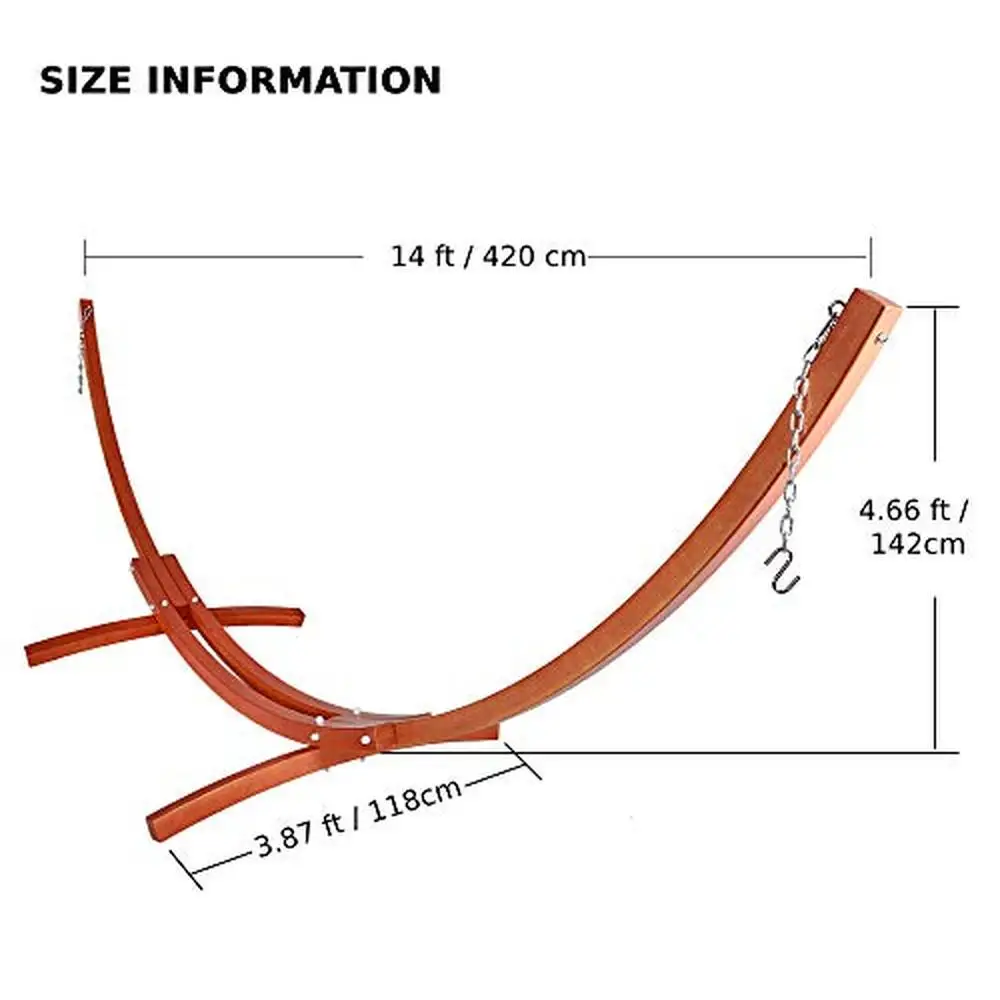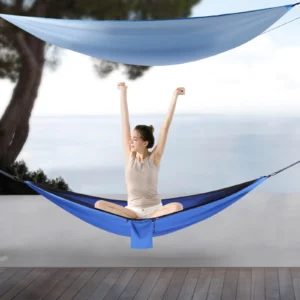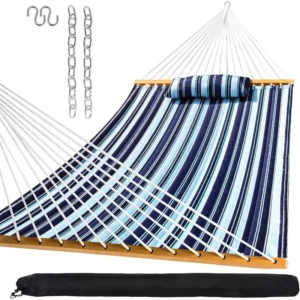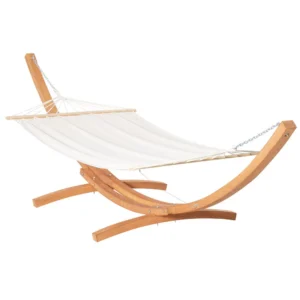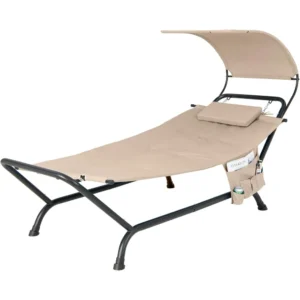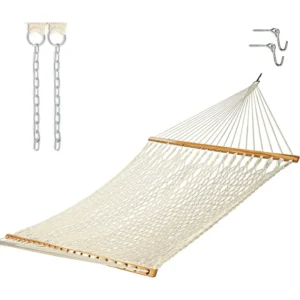Understanding Spreader Bar Hammocks
Spreader bars are rigid wooden or metal rods attached to both ends of certain hammock styles. These bars serve a specific purpose: to stretch the hammock fabric horizontally, creating a flat, open surface for lounging. Unlike traditional gathered-end hammocks that naturally form a cocoon shape, spreader bar designs maintain an open, bed-like surface that many find visually appealing.
The history of spreader bars dates back to American hammock innovation in the early 20th century. Designed to make hammocks more accessible and visually inviting, they quickly became a staple in backyards across North America. Today, they represent what many people first visualize when thinking of a classic hammock.
Spreader bar configurations vary considerably across different designs:
- Single vs. Double Bar: Some hammocks feature a single spreader bar at each end, while others use double bar systems for enhanced stability and fabric tension.
- Fixed vs. Adjustable: Modern designs may include adjustable spreader bars that allow users to modify the fabric tension.
- Material Variations: Traditional hardwoods like oak or walnut remain popular, but aluminum and composite materials offer lightweight, weather-resistant alternatives.
The typical spreader bar measures between 40-55 inches (100-140 cm) in length, depending on the hammock’s width. These bars are positioned at the very ends of the hammock, creating that distinctive flat, open profile that characterizes American-style hammocks. The classic rope hammock with wooden spreader bars represents the most recognizable version of this design, though fabric variants have gained popularity for their comfort.
Strategic indoor and outdoor hammock placement is particularly important with spreader bar designs due to their unique balance characteristics. The positioning of these rigid components fundamentally changes how users interact with the hammock.
At Outside Luxe, we offer various spreader bar hammock sets that combine both traditional appeal and modern engineering improvements to address some of the balance challenges we’ll explore in this article.
The Physics of Hammock Balance: Center of Gravity
To understand why spreader bar hammocks behave differently than their gathered-end counterparts, we need to examine some basic physics principles—particularly the concept of center of gravity.
The center of gravity represents the point where an object’s weight is perfectly balanced. In any suspended system like a hammock, stability depends largely on where this center of gravity falls relative to the suspension points.
Spreader bars fundamentally alter how your weight is distributed when lying in a hammock:
- They create a flatter surface that raises your center of gravity
- They establish a more rigid structure that’s less forgiving of weight shifts
- They distribute weight more evenly across the fabric surface
This higher center of gravity is the primary reason spreader bar hammocks respond differently to movement. When your weight is positioned higher above the suspension line (the imaginary line between the two hanging points), even small shifts in position can create momentum that’s harder to counterbalance.
Think of it like carrying a load on your head versus carrying it at waist level—the higher-positioned weight becomes more challenging to balance as you move.
In contrast, spreader bar vs gathered-end hammocks show significant differences in stability behavior. Gathered-end designs naturally create a lower center of gravity as the fabric forms a pocket that cradles your body closer to the suspension line. This lower position makes the system inherently more forgiving of movement.
The physics explains why spreader bar hammocks, while visually appealing and comfortable, require different usage techniques than their traditional counterparts to ensure a safe, stable lounging experience.
How Spreader Bars Create a Flatter Laying Surface
The primary function of spreader bars is to tension the hammock fabric laterally, preventing it from gathering in the middle. This tension transforms what would naturally be a deep curve into a remarkably flat surface that resembles a suspended bed more than a traditional hammock.
This flat surface creates several distinct effects on your hammock experience:
- Eliminates the natural “cocoon” effect of traditional hammocks
- Distributes body weight more evenly across the fabric
- Creates a more bed-like lying experience
- Allows for multiple sleeping positions, including side-lying
- Provides better visibility of surroundings while lounging
The fabric distribution across the spreader bars is critical to this effect. The bars force the material to remain open, creating tension that supports your body weight in a more horizontal plane. Without this tension, hammock fabrics naturally form a deep curve when bearing weight.
This flatness significantly changes how your body interacts with the hammock surface. Rather than being cradled in fabric with your weight concentrated in the center, spreader bar designs distribute pressure more evenly across your body. This can reduce pressure points for some sleepers but eliminates the natural “hugging” sensation many hammock enthusiasts enjoy.
Traditional rope hammock sets with spreader bars exemplify this flat design approach. The classic lattice of ropes stretched across wooden bars creates the iconic flat surface that many people immediately associate with leisure hammocking.
It’s worth noting that while the flat surface might seem inherently more comfortable to newcomers, especially those accustomed to conventional beds, this flatness directly contributes to the balance challenges discussed throughout this article.
The Tipping Phenomenon: Why Spreader Bar Hammocks Flip
The notorious “tipping phenomenon” associated with spreader bar hammocks isn’t just anecdotal—it’s a direct result of the physics we’ve discussed. Understanding why these hammocks sometimes flip can help you avoid unexpected spills.
The mechanics behind the flipping tendency include:
- The raised center of gravity creates a less stable equilibrium
- The rigid structure doesn’t conform to your body or adjust to weight shifts
- The flat surface creates less “capture” effect to keep you centered
- The even weight distribution means less resistance to rolling momentum
Specific movements most likely to trigger instability include:
- Sitting directly on the edge rather than in the center
- Rolling quickly from one side to another
- Sitting up suddenly from a lying position
- Uneven weight distribution (like leaning far to one side)
- Bouncing or swinging motions
- Improper entry or exit techniques
The highest-risk moments typically occur during entry and exit, when your weight is distributed asymmetrically across the hammock surface. Without proper technique, these transitions can quickly lead to the hammock flipping completely over.

Unlike traditional gathered-end designs that create a natural pocket that captures your weight at the lowest point, spreader bar hammocks maintain their flat profile regardless of where your weight is placed. This means they have less built-in correction for off-center weight distribution.
Proper hammock installation requirements and safety guidelines are especially critical for spreader bar designs to minimize tipping risks. The right height, tension, and anchor points can significantly reduce instability issues.
Benefits of Spreader Bar Designs Despite Balance Challenges
While we’ve highlighted the balance challenges of spreader bar hammocks, these designs offer numerous benefits that explain their enduring popularity:
- Superior visibility: The flat, open design provides unobstructed views of your surroundings, perfect for scenic locations.
- Enhanced airflow: The spread fabric allows better air circulation, keeping you cooler on hot days compared to enclosed hammock designs.
- Easier accessibility: Many users, especially those with mobility limitations, find entry and exit simpler than with deep-pocket traditional hammocks.
- Aesthetic appeal: The open, inviting appearance makes spreader bar hammocks an attractive addition to outdoor spaces.
- More sleeping positions: The flat surface accommodates side and stomach sleepers better than gathered designs.
- Faster drying: After rain or morning dew, the open design allows for quicker drying times.
- Reduced claustrophobia: Users who feel confined in traditional hammocks often prefer the open design.
For many hammock enthusiasts, these advantages outweigh the additional balance considerations. With proper setup and technique, the stability issues can be effectively managed.
Mastering your oasis with spreader bar hammocks and frames becomes easier when you understand both their advantages and limitations. The right setup can maximize the benefits while minimizing potential drawbacks.
Non-Spreader Bar Hammocks: The Stability Comparison
To fully understand how spreader bars affect balance, it’s helpful to compare them with traditional non-spreader designs:
| Feature | Spreader Bar Hammocks | Non-Spreader Bar Hammocks |
|---|---|---|
| Center of gravity | Higher (less stable) | Lower (more stable) |
| Entry difficulty | Moderate, requires technique | Higher, requires more flexibility |
| Movement forgiveness | Low – sensitive to shifts | High – adapts to movement |
| Flip potential | Higher | Very low |
| Sleeping positions | Multiple, including side-sleeping | Primarily back-lying (diagonal for comfort) |
| Learning curve | Steeper for safe use | Minimal for basic use |
Traditional gathered-end hammocks create a natural “cocoon” effect where the fabric wraps partially around you. This design naturally lowers your center of gravity below the suspension points, creating inherent stability.
The fabric in these traditional designs flexibly responds to your movements, shifting and adjusting to maintain balance rather than resisting changes. This adaptability means even substantial movement typically results in gentle swaying rather than tipping.
A key technique with traditional hammocks is the diagonal lay, where users position themselves at an angle across the hammock’s centerline. This creates a remarkably flat sleeping surface without needing spreader bars. Brazilian and Mayan hammock designs exemplify this approach, offering comfortable, stable lounging through fabric manipulation rather than rigid components.
For users prioritizing stability above all else, camping hammocks with stands often feature non-spreader designs specifically engineered to prevent tipping while maintaining comfort.
A-Frame Stand Hammock Sets, Swinging Hammock Chair Sets
$154.62 Select options This product has multiple variants. The options may be chosen on the product pageCamping Hammock Sets with Bug Net, Ultralight Camping Hammock Sets
$139.72 Select options This product has multiple variants. The options may be chosen on the product pageClassic Wooden Stand Hammock Sets, Heavy Duty Hammock Sets
$1,061.68 Select options This product has multiple variants. The options may be chosen on the product pageHammock Sets with Canopy, Heavy Duty Hammock Sets
$286.31 Select options This product has multiple variants. The options may be chosen on the product pageDouble / Two Person Hammock Sets, Rope Hammock Sets
Double Traditional Cotton Rope Hammock with Extension Chains – 450 lbs Capacity for Backyard & Patio$292.98 Select options This product has multiple variants. The options may be chosen on the product page
Safe Entry and Exit Techniques for Spreader Bar Hammocks
Mastering proper entry and exit techniques is essential for safely enjoying spreader bar hammocks:
Safe Entry Method:
1. Approach the hammock from the center, not the sides
2. Place your hand on both edges to stabilize the hammock
3. Sit down slowly in the exact center of the hammock
4. Keep your weight centered as you pivot your legs up
5. Maintain even weight distribution as you recline
6. Move slowly throughout the entire process
Safe Exit Strategy:
1. Return to a seated position in the center
2. Keep both hands on the hammock edges for stability
3. Pivot your legs over the side while maintaining centered weight
4. Stand up slowly and deliberately
5. Maintain contact with the hammock until fully standing
6. Never exit by rolling to one side
Common mistakes to avoid include sitting on the very edge, entering from the side rather than the center, making sudden movements, or trying to exit by rolling sideways out of the hammock.
Hand positioning is particularly important—always maintain contact with both sides of the hammock during transitions to stabilize the fabric and prevent unexpected shifts. Finding the best indoor and outdoor hammock locations with adequate clearance around all sides helps ensure you have enough space to enter and exit safely.
With practice, these techniques become second nature, allowing you to enjoy your spreader bar hammock without fear of unexpected flipping.
Optimal Hanging Guidelines for Enhanced Stability
Proper installation significantly impacts the stability of spreader bar hammocks. Follow these guidelines for the best balance:
- Ideal hanging height: Position the hammock 18-24 inches (45-60 cm) from the ground when unoccupied
- Optimal tension: Aim for a slight curve when empty—too tight increases tipping risk
- Anchor point distance: Generally 2-3 feet (60-90 cm) longer than the hammock’s total length
- Evenness: Ensure both anchor points are at identical heights
- Anchor strength: Use supports rated for at least 800 pounds (363 kg)
- Stand stability: If using a stand, ensure it’s on level ground with all parts fully secured
The relationship between hanging height and stability is particularly important. Hanging too high increases the consequences of a flip, while hanging too low can create uncomfortable ground contact when the hammock is weighted.
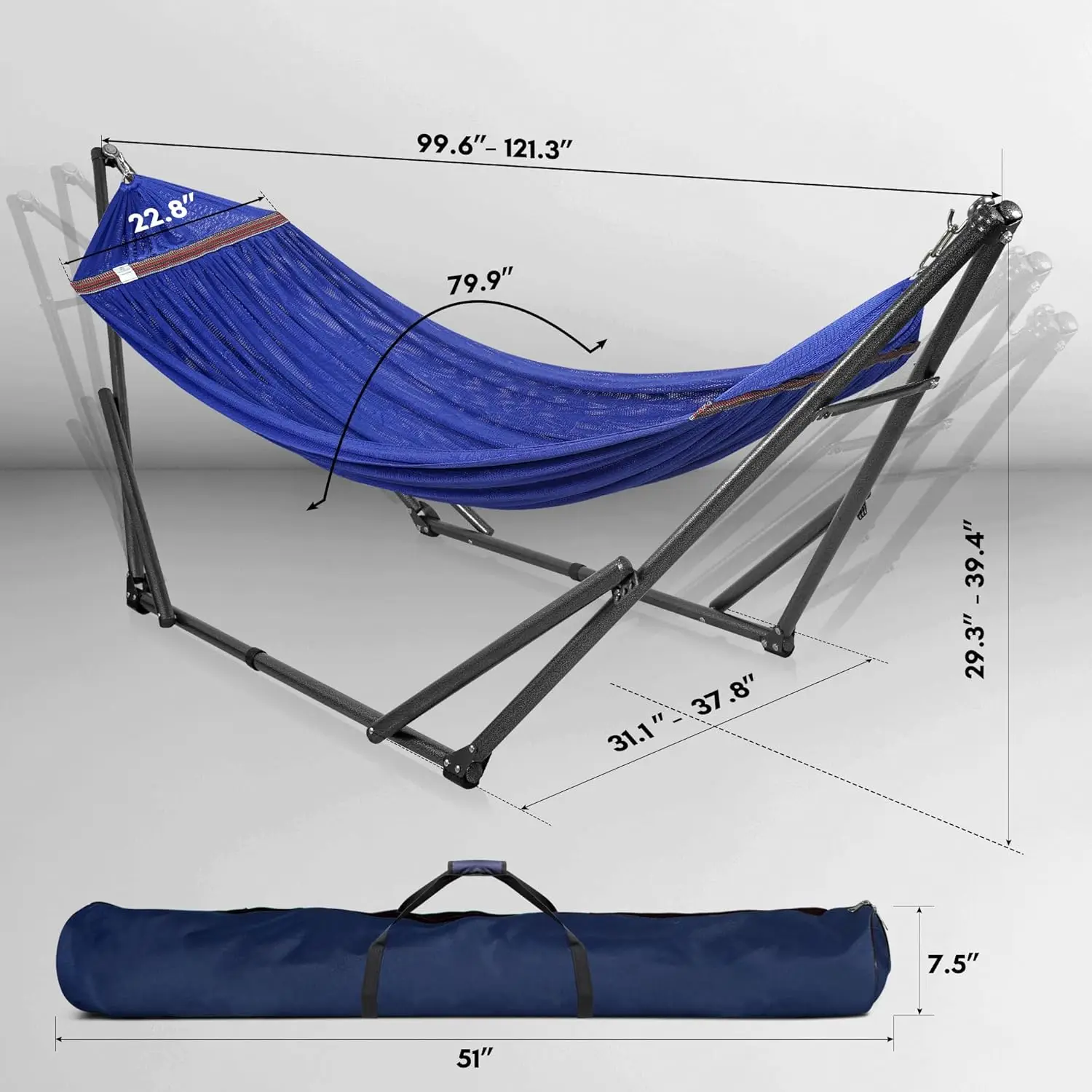
Signs of improper hanging include excessive swinging, visible tilting to one side when weighted, or difficulty maintaining position in the center. Any of these indicators suggest adjustments are needed.
Wooden arc stand hammock sets provide excellent stability for spreader bar hammocks because they’re specifically designed to maintain optimal hanging geometry and height.
Weight Distribution Strategies for Balanced Relaxation
Maintaining proper weight distribution is crucial for stable hammock enjoyment:
- Always position yourself in the center of the hammock
- Distribute weight evenly across both sides of the centerline
- Keep your heaviest body parts (typically torso) aligned with the hammock’s center
- Make movements deliberately and gradually
- Maintain awareness of your position relative to center
- Correct any drift toward edges immediately
Different activities require specific positioning strategies:
For reading:
– Use a small pillow under your head rather than propping yourself up on an elbow
– Keep books or devices centered over your torso
– Avoid leaning heavily to one side to reach items
For napping:
– Lie with your head at the center of one end and feet at center of opposite end
– Avoid curling up on one side of the hammock
– Use body-length pillows for side-sleeping support
For conversation:
– Maintain a centered seated position
– Resist the urge to turn fully toward your conversation partner
– Use small weight shifts rather than full body repositioning
Learning to tame the wobble and stabilize your hammock stand complements these weight distribution techniques for a more stable experience overall.
Design Variations: How Different Spreader Bar Designs Affect Stability
Not all spreader bar designs offer identical stability characteristics. Modern innovations have attempted to address balance concerns while maintaining the appealing flat surface:
Traditional Straight Bars vs. Curved Designs:
– Curved spreader bars better follow body contours
– Arc-shaped bars can lower the overall center of gravity
– Curved designs often provide better edge stability
Length Variations:
– Shorter spreader bars (under 40 inches/100 cm) generally improve stability but reduce flatness
– Longer bars (over 55 inches/140 cm) maximize the flat surface but may decrease stability
– The ideal length depends on hammock width and intended use
Bar Positioning:
– Bars positioned closer to the suspension points generally increase stability
– Some designs use multiple smaller bars along the hammock length
– Distance from ends affects both stability and comfort
Material choice also impacts performance. The materials used in spreader bar hammocks range from traditional hardwoods to modern composites, each affecting weight distribution and responsiveness differently. Heavier materials can lower the overall center of gravity but make the hammock less responsive to stabilizing adjustments.
Innovative hybrid designs that incorporate elements of both spreader and non-spreader hammocks represent the cutting edge of stability improvement. These designs aim to preserve the flat surface while addressing the inherent balance challenges.
Are Spreader Bar Hammocks Suitable for Sleeping?
Many hammock enthusiasts wonder whether spreader bar designs work well for overnight sleeping. The answer depends on several factors:
Overnight Sleeping Considerations:
– Spreader bar hammocks require more conscious position maintenance during sleep
– Natural sleep movements can trigger instability
– Temperature regulation is superior to gathered-end designs
– Side-sleeping is more comfortable than in traditional hammocks
– Entering/exiting during nighttime requires extra caution
For those determined to sleep in spreader bar hammocks, these tips can help:
– Position yourself perfectly centered before falling asleep
– Consider using a sleeping bag or light blanket to reduce unconscious movement
– Place the hammock at a lower height than daytime lounging
– Ensure anchor points are extremely secure
– Practice conscious sleep positions that maintain centeredness
Traditional gathered-end camping hammocks generally provide superior overnight sleeping stability and are preferred by most experienced hammock campers. However, some people genuinely prefer the flat sleeping surface of spreader bar designs.
For various overnight and daytime relaxation needs, exploring different hammock and stand options can help you find the perfect balance between comfort and stability for your specific preferences.
Multi-Person Use: Special Considerations for Shared Hammocking
Sharing a spreader bar hammock significantly increases stability challenges:
- Combined weight creates more pronounced movement when either person shifts
- Finding and maintaining center balance becomes more complex
- Entry and exit require careful coordination
- Weight capacity limits become more critical
If you’re determined to share a spreader bar hammock, follow these guidelines:
- The larger/heavier person should enter first and position themselves in the center
- The second person should enter slowly from the same side
- Both users should maintain centered positions relative to the hammock’s long axis
- Avoid sudden movements or weight shifts
- Coordinate entry and exit, never entering or exiting simultaneously
- Stay within the manufacturer’s stated weight capacity (typically 400-600 lbs/181-272 kg)
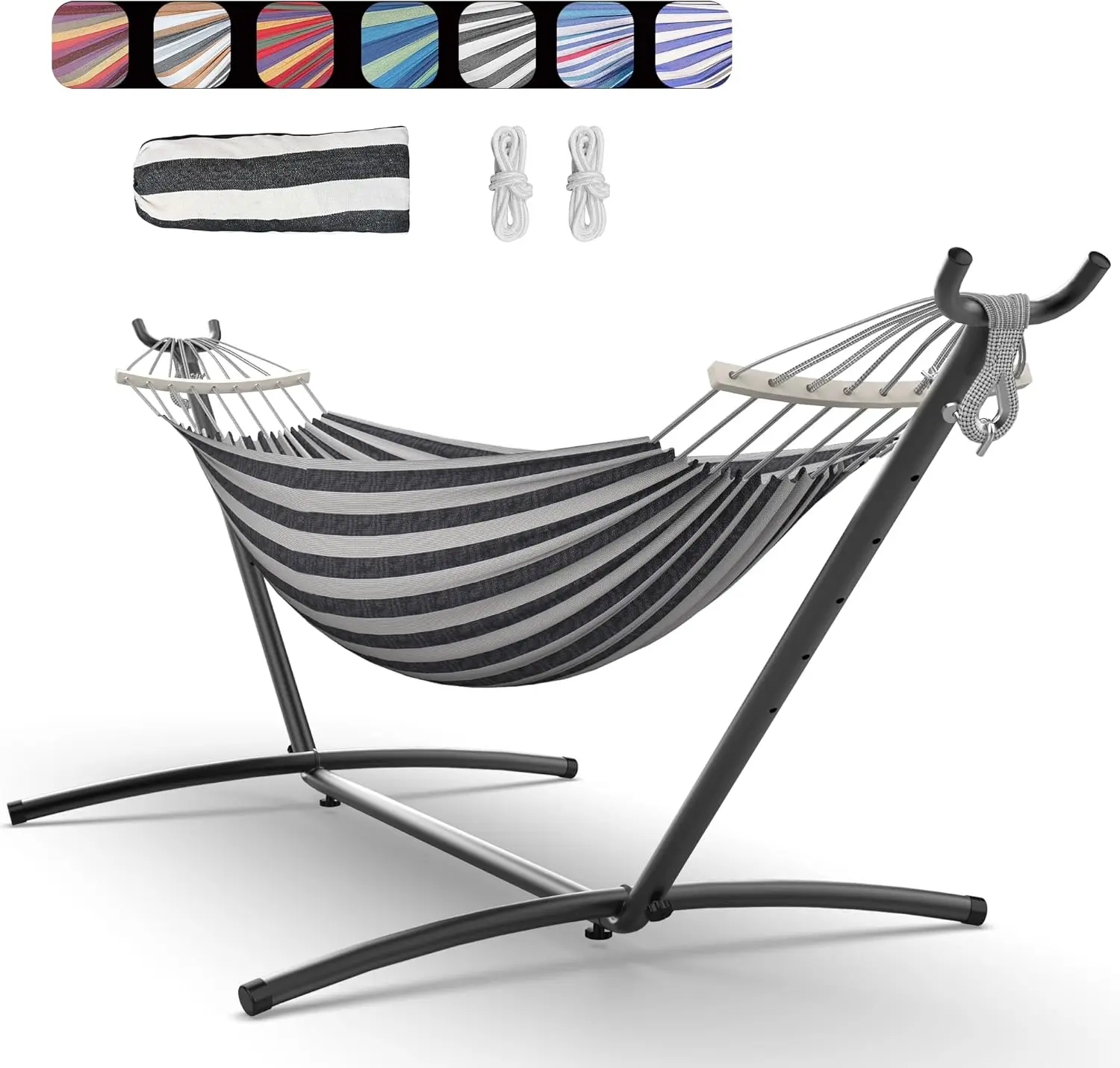
For a more stable shared experience, double two-person hammock sets specifically designed for multiple users often incorporate stability-enhancing features like wider spreader bars or reinforced central sections.
Weather Factors: Wind and Stability
Environmental conditions significantly impact spreader bar hammock stability:
Wind Effects:
– The flat, open surface acts like a sail, catching wind
– Side winds can create lifting forces that exacerbate instability
– Gusting winds cause unpredictable movement
– Lightweight spreader bar hammocks are particularly susceptible
Stability Strategies for Windy Conditions:
– Position the hammock with its length parallel to prevailing winds when possible
– Lower the hanging height slightly in windy conditions
– Consider temporary windbreaks for exposed locations
– Use hammocks with ventilated mesh designs that allow some wind passage
– Add weight to the hammock when not in use to prevent lifting
Rain and moisture also affect stability by making surfaces slippery and changing fabric tension. Properly waterproofed hammocks maintain more consistent performance in varying weather.
Understanding whether it’s okay to leave your hammock outside in different weather conditions helps preserve both the hammock and your safety when using it.
Choosing Between Stability and Aesthetics: Making the Right Decision
Selecting the right hammock involves balancing stability needs with aesthetic preferences:
When Spreader Bar Designs Excel:
– Primarily decorative settings where appearance is paramount
– Casual daytime lounging in controlled environments
– Situations where easy entry/exit is critical
– Environments where temperature control and airflow are priorities
– Users who strongly prefer a flat lying surface
When Traditional Designs May Be Better:
– Overnight sleeping or extended lounging
– Locations with variable weather conditions
– Users concerned about stability or safety
– Situations requiring frequent repositioning
– Environments where setup space is limited
The ideal compromise often depends on your primary use case. Some questions to consider:
– How long will you typically spend in the hammock at once?
– Who will be using the hammock? (Children, elderly, or mobility-challenged users)
– How important is the visual appearance in your space?
– Will the hammock be used primarily indoors or outdoors?
– Do you plan to sleep overnight in the hammock?
By understanding how spreader bars fundamentally affect hammock balance and stability, you can make an informed choice that matches your specific needs and preferences. Whether you prioritize the classic look of a spreader bar design or the inherent stability of traditional hammocks, the perfect balance for your relaxation awaits.

